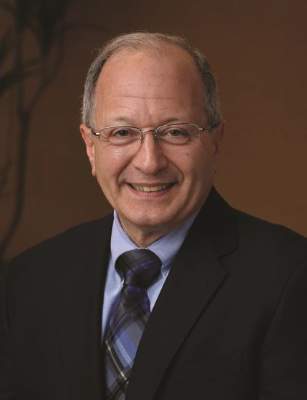User login
Patients with Barrett’s esophagus, a condition in which cells lining the esophagus are replaced by the type of cells that normally line the intestine, need to be monitored carefully to prevent the development of esophageal cancer, a gastroenterologist expert in the condition said here at Digestive Diseases: New Advances. The condition can occur following exposure to stomach acids and bile from gastroesophageal reflux disease (GERD).
“The reason we worry about Barrett’s is because it’s a major risk factor for developing esophageal adenocarcinoma, and that’s a tumor that has been experiencing an enormous increase in frequency over the past few decades,” said Dr. Stuart Spechler, chief of gastroenterology for the VA North Texas Healthcare System and co-director of the Esophageal Diseases Center at the University of Texas Southwestern Medical Center in Dallas.
The incidence of esophageal adenocarcinoma increased more than sevenfold over 33 years, going from 3.6 per million in 1973 to 25.6 per million in 2006. Barrett’s esophagus affects about 5.6% of U.S. adults, he noted.
Endoscopic screening for Barrett’s esophagus is recommended for patients with multiple risk factors for esophageal cancer, including chronic GERD (having GERD for more than 5 years), hiatal hernia, age of at least 50 years, male gender, white race, and an elevated body mass index, especially if there’s an intra-abdominal body fat distribution, Dr. Spechler said.
Barrett’s esophagus traditionally is treated with proton pump inhibitors because of their ability to decrease gastric acid production and acid reflux and heal reflux esophagitis. “We also recommend that these patients have regular endoscopic surveillance to look for precancerous changes,” most notably dysplasia, he said. If no dysplasia is found, patients should receive a repeat endoscopy every 3-5 years. Patients with high-grade dysplasia should be treated with endoscopic eradication therapy. The risk of developing cancer in patients with high-grade dysplasia is about 6% per year, he said, which is “sufficient to warrant intervention.”
For patients with visible mucosal irregularities, endoscopic mucosal resection can determine how far the neoplasms have spread, Dr. Spechler said.
For those neoplasms confined to the mucosa, like high-grade dysplasia, radiofrequency ablation can be used to burn the abnormal mucosa away. As the esophagus heals, normal cells grow back. The procedure is safe and effective and has been shown to prevent neoplastic progression at 1 year, he said – the most serious complication is esophageal stricture (N. Engl. J. Med. 2009;360:2277-88). Radiofrequency ablation also can be considered in patients with low-grade dysplasia, and even for highly selected patients with nondysplastic Barrett’s esophagus deemed to be at increased risk for progression to high-grade dysplasia or cancer.
“We do worry about Barrett’s esophagus recurring after endoscopic eradication, and there is a rate of recurrence, but this newer treatment seems to be very effective, at least in the short term, for preventing progression to cancer,” he said.
More advanced cancers can be treated by surgery and chemotherapy or radiation therapy.
Overall, “this is a condition that’s increasing in frequency, and we do worry about it, but as long as you are treating patients, screening for Barrett’s esophagus, and following them regularly with surveillance, the prognosis for any individual patient is really excellent,” he said at the meeting, which was held by Global Academy for Medical Education and Rutgers, the State University of New Jersey. Global Academy and this news organization are owned by the same company.
Dr. Spechler has served a consultant for Takeda Pharmaceuticals and is currently a consultant for Interpace Diagnostics.
Patients with Barrett’s esophagus, a condition in which cells lining the esophagus are replaced by the type of cells that normally line the intestine, need to be monitored carefully to prevent the development of esophageal cancer, a gastroenterologist expert in the condition said here at Digestive Diseases: New Advances. The condition can occur following exposure to stomach acids and bile from gastroesophageal reflux disease (GERD).
“The reason we worry about Barrett’s is because it’s a major risk factor for developing esophageal adenocarcinoma, and that’s a tumor that has been experiencing an enormous increase in frequency over the past few decades,” said Dr. Stuart Spechler, chief of gastroenterology for the VA North Texas Healthcare System and co-director of the Esophageal Diseases Center at the University of Texas Southwestern Medical Center in Dallas.
The incidence of esophageal adenocarcinoma increased more than sevenfold over 33 years, going from 3.6 per million in 1973 to 25.6 per million in 2006. Barrett’s esophagus affects about 5.6% of U.S. adults, he noted.
Endoscopic screening for Barrett’s esophagus is recommended for patients with multiple risk factors for esophageal cancer, including chronic GERD (having GERD for more than 5 years), hiatal hernia, age of at least 50 years, male gender, white race, and an elevated body mass index, especially if there’s an intra-abdominal body fat distribution, Dr. Spechler said.
Barrett’s esophagus traditionally is treated with proton pump inhibitors because of their ability to decrease gastric acid production and acid reflux and heal reflux esophagitis. “We also recommend that these patients have regular endoscopic surveillance to look for precancerous changes,” most notably dysplasia, he said. If no dysplasia is found, patients should receive a repeat endoscopy every 3-5 years. Patients with high-grade dysplasia should be treated with endoscopic eradication therapy. The risk of developing cancer in patients with high-grade dysplasia is about 6% per year, he said, which is “sufficient to warrant intervention.”
For patients with visible mucosal irregularities, endoscopic mucosal resection can determine how far the neoplasms have spread, Dr. Spechler said.
For those neoplasms confined to the mucosa, like high-grade dysplasia, radiofrequency ablation can be used to burn the abnormal mucosa away. As the esophagus heals, normal cells grow back. The procedure is safe and effective and has been shown to prevent neoplastic progression at 1 year, he said – the most serious complication is esophageal stricture (N. Engl. J. Med. 2009;360:2277-88). Radiofrequency ablation also can be considered in patients with low-grade dysplasia, and even for highly selected patients with nondysplastic Barrett’s esophagus deemed to be at increased risk for progression to high-grade dysplasia or cancer.
“We do worry about Barrett’s esophagus recurring after endoscopic eradication, and there is a rate of recurrence, but this newer treatment seems to be very effective, at least in the short term, for preventing progression to cancer,” he said.
More advanced cancers can be treated by surgery and chemotherapy or radiation therapy.
Overall, “this is a condition that’s increasing in frequency, and we do worry about it, but as long as you are treating patients, screening for Barrett’s esophagus, and following them regularly with surveillance, the prognosis for any individual patient is really excellent,” he said at the meeting, which was held by Global Academy for Medical Education and Rutgers, the State University of New Jersey. Global Academy and this news organization are owned by the same company.
Dr. Spechler has served a consultant for Takeda Pharmaceuticals and is currently a consultant for Interpace Diagnostics.
Patients with Barrett’s esophagus, a condition in which cells lining the esophagus are replaced by the type of cells that normally line the intestine, need to be monitored carefully to prevent the development of esophageal cancer, a gastroenterologist expert in the condition said here at Digestive Diseases: New Advances. The condition can occur following exposure to stomach acids and bile from gastroesophageal reflux disease (GERD).
“The reason we worry about Barrett’s is because it’s a major risk factor for developing esophageal adenocarcinoma, and that’s a tumor that has been experiencing an enormous increase in frequency over the past few decades,” said Dr. Stuart Spechler, chief of gastroenterology for the VA North Texas Healthcare System and co-director of the Esophageal Diseases Center at the University of Texas Southwestern Medical Center in Dallas.
The incidence of esophageal adenocarcinoma increased more than sevenfold over 33 years, going from 3.6 per million in 1973 to 25.6 per million in 2006. Barrett’s esophagus affects about 5.6% of U.S. adults, he noted.
Endoscopic screening for Barrett’s esophagus is recommended for patients with multiple risk factors for esophageal cancer, including chronic GERD (having GERD for more than 5 years), hiatal hernia, age of at least 50 years, male gender, white race, and an elevated body mass index, especially if there’s an intra-abdominal body fat distribution, Dr. Spechler said.
Barrett’s esophagus traditionally is treated with proton pump inhibitors because of their ability to decrease gastric acid production and acid reflux and heal reflux esophagitis. “We also recommend that these patients have regular endoscopic surveillance to look for precancerous changes,” most notably dysplasia, he said. If no dysplasia is found, patients should receive a repeat endoscopy every 3-5 years. Patients with high-grade dysplasia should be treated with endoscopic eradication therapy. The risk of developing cancer in patients with high-grade dysplasia is about 6% per year, he said, which is “sufficient to warrant intervention.”
For patients with visible mucosal irregularities, endoscopic mucosal resection can determine how far the neoplasms have spread, Dr. Spechler said.
For those neoplasms confined to the mucosa, like high-grade dysplasia, radiofrequency ablation can be used to burn the abnormal mucosa away. As the esophagus heals, normal cells grow back. The procedure is safe and effective and has been shown to prevent neoplastic progression at 1 year, he said – the most serious complication is esophageal stricture (N. Engl. J. Med. 2009;360:2277-88). Radiofrequency ablation also can be considered in patients with low-grade dysplasia, and even for highly selected patients with nondysplastic Barrett’s esophagus deemed to be at increased risk for progression to high-grade dysplasia or cancer.
“We do worry about Barrett’s esophagus recurring after endoscopic eradication, and there is a rate of recurrence, but this newer treatment seems to be very effective, at least in the short term, for preventing progression to cancer,” he said.
More advanced cancers can be treated by surgery and chemotherapy or radiation therapy.
Overall, “this is a condition that’s increasing in frequency, and we do worry about it, but as long as you are treating patients, screening for Barrett’s esophagus, and following them regularly with surveillance, the prognosis for any individual patient is really excellent,” he said at the meeting, which was held by Global Academy for Medical Education and Rutgers, the State University of New Jersey. Global Academy and this news organization are owned by the same company.
Dr. Spechler has served a consultant for Takeda Pharmaceuticals and is currently a consultant for Interpace Diagnostics.

